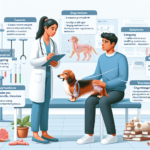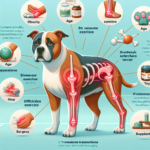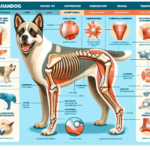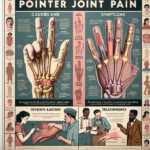Dachshund Joint Pain: Causes, Symptoms, Prevention, and Treatment

Introduction
The Dachshund, affectionately known as the “wiener dog” due to its long body and short legs, is a breed with a rich history and unique characteristics. Originating in Germany, Dachshunds were initially bred for hunting badgers, a task that required a dog with a strong, elongated body and a fearless disposition. Today, they are beloved family pets known for their playful nature, loyalty, and distinctive appearance.
While Dachshunds are generally healthy dogs, they are prone to certain health issues, particularly those related to their unique body structure. One of the most significant concerns for Dachshund owners is joint pain, which can severely impact the quality of life for these dogs. Given their long spine and short legs, maintaining joint health is crucial for Dachshunds to lead active and pain-free lives.
Breed-Specific Joint Pain Risks
Genetic Predisposition
Dachshunds are genetically predisposed to several joint-related issues. One of the most common is intervertebral disc disease (IVDD), a condition where the discs between the vertebrae of the spine deteriorate or herniate, causing pain and mobility issues. Additionally, Dachshunds can suffer from hip dysplasia, a genetic condition where the hip joint doesn’t fit properly into the hip socket, leading to arthritis and pain over time.
Age-Related Risks
As Dachshunds age, the risk of joint pain increases. The wear and tear on their joints and spine can lead to conditions like arthritis, which is characterized by inflammation and stiffness in the joints. Owners should be particularly vigilant as their Dachshund approaches middle age, typically around 5-7 years old, as this is when joint issues often begin to manifest.
Activity Level and Joint Stress
Dachshunds are active dogs that enjoy play and exercise, but their unique body structure means that certain activities can put undue stress on their joints. Jumping from heights, running on hard surfaces, and excessive climbing can all contribute to joint stress and exacerbate existing conditions. It’s essential to balance their need for exercise with activities that are safe for their joints.
Common Symptoms of Joint Pain in Dachshunds
General Symptoms
- Limping or favoring one leg
- Stiffness, especially after rest
- Reluctance to move, jump, or climb stairs
- Whining or yelping in pain
- Decreased activity level
- Swelling around the joints
Breed-Specific Symptoms
In Dachshunds, symptoms of joint pain may also include a hunched back or an unusual gait due to their long spine. They may also exhibit signs of discomfort when their back is touched or manipulated. Given their predisposition to IVDD, any sudden changes in mobility or signs of severe pain should be taken seriously.
When to Consult a Vet
If your Dachshund shows any signs of joint pain, it’s crucial to consult a veterinarian promptly. Early intervention can prevent further deterioration and improve the dog’s quality of life. Immediate veterinary attention is necessary if your dog shows signs of severe pain, sudden paralysis, or loss of bladder or bowel control, as these could indicate a serious condition like IVDD.
Preventive Measures for Joint Health
Exercise Recommendations
Regular, moderate exercise is essential for maintaining joint health in Dachshunds. Activities like short walks, gentle play, and swimming are excellent options. Avoid high-impact activities like jumping or running on hard surfaces. Instead, focus on exercises that strengthen the muscles supporting the joints without causing undue stress.
Dietary Suggestions
A balanced diet rich in essential nutrients can support joint health. Look for dog foods that contain glucosamine and chondroitin, which help maintain cartilage health. Omega-3 fatty acids, found in fish oil supplements, can reduce inflammation and support joint function. Always consult your veterinarian before adding supplements to your dog’s diet.
Weight Management
Maintaining a healthy weight is crucial for reducing joint stress in Dachshunds. Excess weight puts additional pressure on the joints and can exacerbate conditions like arthritis. Monitor your dog’s weight and adjust their diet and exercise routine as needed to keep them at an optimal weight.
Early Screening and Monitoring
Regular veterinary check-ups are essential for early detection of joint issues. Your vet may recommend screening tests such as X-rays or MRI scans to monitor joint health. Early intervention can significantly improve outcomes and prevent severe pain and mobility issues.
Treatment Options for Joint Pain
Non-Surgical Treatments
Non-surgical treatments for joint pain in Dachshunds include medications like nonsteroidal anti-inflammatory drugs (NSAIDs) to reduce pain and inflammation. Physical therapy can also be beneficial, with exercises designed to strengthen the muscles supporting the joints. Lifestyle adjustments, such as using ramps instead of stairs and providing orthopedic beds, can also alleviate joint stress.
Surgical Options
In severe cases, surgical intervention may be necessary. Common surgeries for joint pain in Dachshunds include spinal decompression surgery for IVDD and hip replacement surgery for severe hip dysplasia. These procedures can significantly improve mobility and quality of life but should be considered only after exploring non-surgical options.
Alternative Therapies
Alternative treatments like acupuncture, hydrotherapy, and massage can also benefit Dachshunds with joint pain. Acupuncture can help reduce pain and inflammation, while hydrotherapy provides low-impact exercise that strengthens muscles without stressing the joints. Massage therapy can improve circulation and reduce muscle tension, providing relief from joint pain.
Lifestyle and Management Tips
Daily Care Routine
A daily care routine for a Dachshund with joint pain should include gentle exercise, a balanced diet, and regular monitoring of their condition. Incorporate activities like short walks and swimming into their routine, and provide a comfortable, supportive bed for rest. Regularly check for signs of pain or discomfort and adjust their care routine as needed.
Modifying the Home Environment
Making your home more comfortable for a Dachshund with joint pain can significantly improve their quality of life. Use ramps to help them navigate stairs and furniture, and provide orthopedic beds to support their joints. Ensure that their living space is free of obstacles that could cause falls or injuries.
Long-Term Management
Long-term management of joint pain in Dachshunds involves regular veterinary check-ups, ongoing weight management, and a consistent exercise routine. Keep an open line of communication with your vet to adjust treatment plans as needed and ensure your dog remains active and happy despite their joint issues.
FAQs About Dachshunds and Joint Pain
What are the early signs of joint pain in Dachshunds?
Early signs of joint pain in Dachshunds include limping, stiffness, reluctance to move, and signs of discomfort when touched. If you notice any of these symptoms, consult your veterinarian promptly.
Can joint pain in Dachshunds be prevented?
While genetic predispositions cannot be entirely prevented, you can take steps to reduce the risk of joint pain. Maintain a healthy weight, provide regular, moderate exercise, and ensure a balanced diet rich in joint-supporting nutrients.
Are there specific exercises that are better for Dachshunds with joint pain?
Yes, low-impact exercises like swimming and short, gentle walks are ideal for Dachshunds with joint pain. Avoid high-impact activities like jumping or running on hard surfaces.
What dietary supplements can help with joint health in Dachshunds?
Supplements containing glucosamine, chondroitin, and omega-3 fatty acids can support joint health. Always consult your veterinarian before adding supplements to your dog’s diet.
When should I consider surgery for my Dachshund’s joint pain?
Surgery should be considered when non-surgical treatments are no longer effective, and your dog is experiencing severe pain or mobility issues. Consult your veterinarian to discuss the best options for your dog’s specific condition.
Conclusion
Maintaining joint health is crucial for ensuring a long, active, and pain-free life for your Dachshund. By understanding the breed-specific risks, recognizing early symptoms, and taking preventive measures, you can significantly improve your dog’s quality of life. Regular veterinary check-ups, a balanced diet, and appropriate exercise are key components of joint health management. If joint pain does occur, a range of treatment options, from non-surgical therapies to surgical interventions, can provide relief and improve mobility. Always consult your veterinarian for personalized advice and treatment plans to keep your Dachshund happy and healthy.




